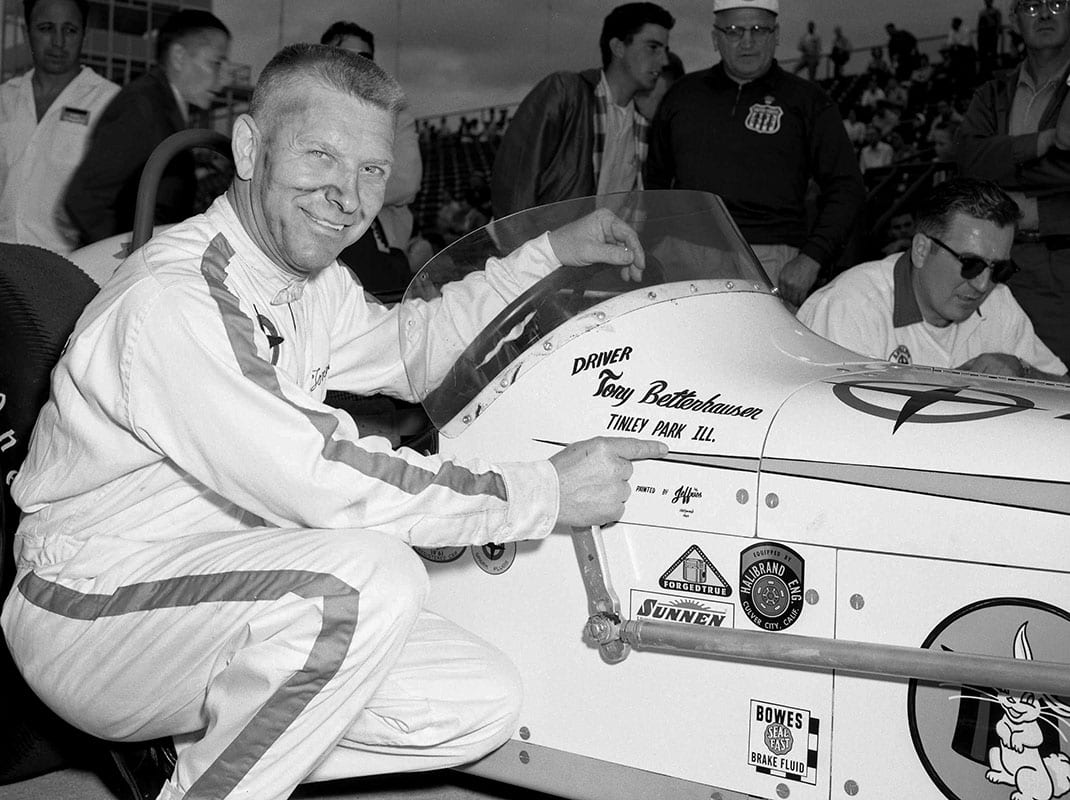CHICAGO – With the 103rd running of the Indianapolis 500 only days away, it seemed appropriate to remember the late Tony Bettenhausen.
Back in the day, when you were talking about the Indianapolis 500 in the Chicagoland region, the name Bettenhausen was always mentioned.
Born and raised on a farm in Tinley Park, Ill., Melvin Eugene Bettenhausen, who got the nickname “Tony” as a youth, became the area’s favorite racing son in the 1940s, 50s and into the 1960s. Bettenhausen made 14 Indianapolis 500 starts from 1946 through 1960, only missing the 1949 race.
Bettenhausen, who began his speed career racing a midget indoors at Chicago’s 124th Field Artillery Armory during the 1937-38 winter season, enjoyed a stellar auto racing career, including two national Indy Car championships, until that tragic day at Indianapolis Motor Speedway in May of 1961.
The story goes that Bettenhausen, who along with the rest of the family tended to the family farm after his father died, pedaled his bicycle some 35 miles to Roby Speedway in Hammond, Ind., to see his first auto race in 1935. After some indoor racing at the Armory, Bettenhausen teamed up with Duke Nalon with the duo traveling out east to compete in midget racing at the fast and sometimes deadly Nutley Velodrome in New Jersey. Bettenhausen took his first outdoor ride in a midget at Nutley in 1938. He was back at the Armory for the indoor action the following winter.

One of Bettenhausen’s earliest local midget feature wins came at Blue Island’s Raceway Park on June 7, 1941 when he drove Wally Zale’s black Offy No. 1 to the 30-lap victory. Bettenhausen was substituting for Zale, the terror of midget race tracks at the time who had been injured at Danville, Ill., the month before.
Winning several heat races and handicap events at Raceway Park in 1940, Bettenhausen would win five feature races at the Raceway oval in 1941 along with track championship honors. In addition to winning track championships at Milwaukee in 1942, ’46 and ’47, Bettenhausen would claim the track championship at Raceway Park again in 1942, ’45 and ’47. He won 35 midget feature races at Raceway Park during his career, making his last appearance there in 1957.
Bettenhausen began to also race sprint cars, or big cars as they were known back then in 1940. In 1941, his ride was the Henry Meyers-owned Iddings Hal out of Dayton, Ohio with Bettenhausen winning his first American Automobile Ass’n (AAA) sprint car feature at Ohio’s high-banked Dayton Speedway on June 22, 1941.
Bettenhausen made his AAA Champ Car debut on the dirt at The Milwaukee Mile on Aug. 24, 1941 when he drove Joe Lencki’s Blue Crown Spark Plug Special to a sixth place finish in the 100-mile contest.
The 1946 season saw Bettenhausen make his first of 14 starts in the Indianapolis 500, finishing 20th after starting 26th in the aged Bristow-McManus, Miller-powered, No. 42 entry, completing 47 laps before a connecting rod broke. Earlier in the month, Bettenhausen had put Carl Marchese’s No. 27 in the field only to have the car withdrawn from the race after a broken crankshaft was found. Bettenhausen won his first career AAA champ car race at Good Time Park in Goshen, N.Y., on Oct. 6, 1946.
In his second year at Indianapolis (1947), Bettenhausen drove the Murrell Belanger No. 29 entry to an 18th place finish after starting 25th. A timing gear problem put him out of the race. He was back in a Belanger car in 1948 and came home in 14th place. Bettenhausen did not make the field in 1949, being bumped during the last day of time trials.
Bettenhausen drove a front-wheel-drive, Offy-powered, Diedt chassis car the next three years, finishing 31st in 1950 for car owner Lou Moore. He finished ninth in 1951 and 24th in 1952. He drove for J.C. Agajanian in 1953 and finished ninth after starting sixth. He was behind the wheel of Mel Wiggers’ No. 10 in 1954 and came home 29th after experiencing engine failure.
For the 1951 race, Bettenhausen was under contract to Lou Moore to drive one of Moore’s Diedt cars which were state of the art pieces in the late 1940s but were beginning to show their age. Bettenhausen had driven Murrell Belanger’s lightweight 1949 Kurtis 327 to two wins in 1950 and two more in 1949 when the car was owned by the original builders – Meyer & Drake. With Bettenhausen in the Moore stable, the ever-proud and somewhat upset Belanger put veteran racer Lee Wallard in his Belanger Motors Special No. 99 for the ’51 race with Wallard winning the 500-miler.
A week or so after his Indianapolis 500 victory, Wallard was seriously burned in a big car/sprint car accident, which pretty much ended his racing career. This set the stage for Bettenhausen and Belanger, the Crown Point, Ind., car owner, to get back together. Bettenhausen, behind the wheel of Belanger’s dark blue racer, went on to win eight of 15 championship races the rest of the ’51 season – setting a single season record for the most wins which stood until 1964 when A.J. Foyt won 10 races. With that performance, Tony Bettenhausen was the 1951 AAA National Champion.
A veteran mechanic , the late Ray Nichels reminisced about the Belanger car in 1999, “Meyer & Drake built that little car that (Tony) Bettenhausen started driving. It had a blown midget engine in it (at first). You couldn’t keep the engine together, but when they turned around a put a full 270 (Offenhauser) engine it in – school was out. You couldn’t run with it.”
